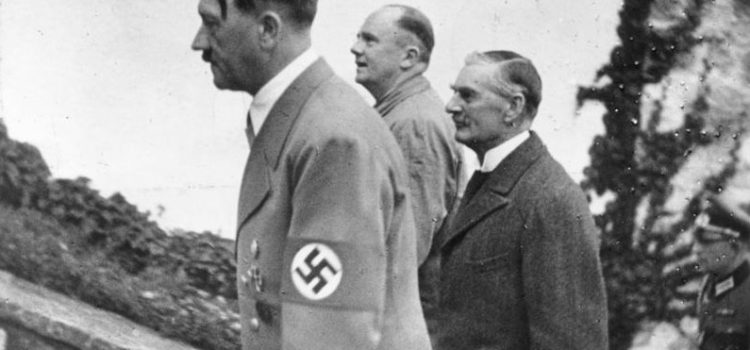

This article is an excerpt from the Shortform book guide to "Talking to Strangers" by Malcolm Gladwell. Shortform has the world's best summaries and analyses of books you should be reading.
Like this article? Sign up for a free trial here .
How did the 1938 meeting between Neville Chamberlain and Hitler go? How did Hitler convince Chamberlain that he only planned to invade Czechoslovakia?
The meetings between Chamberlain and Hitler show how hard it is to spot a lie. Learn about Chamberlain’s attempts to read Hitler and why none of us are very good at understanding strangers.
Neville Chamberlain and Adolf Hitler
Why does meeting a stranger face-to-face sometimes make it harder to make sense of that person than it would be without meeting them at all?
In 1938, Adolf Hitler announced his plan to invade the German-speaking side of Czechoslovakia. In response, British prime minister Neville Chamberlain decided to go to Germany and meet with Adolf Hitler face-to-face. Chamberlain hoped to look Hitler in the eyes, get a sense of his true intentions, and measure Hitler’s capacity to be reasoned with. This was considered a daring move in the effort to avoid a world war, mostly because of how few diplomats had ever done such a thing.
On September 15, Chamberlain arrived at Hitler’s retreat in Berchtesgaden, Germany. There, Hitler said, in no uncertain terms, that he planned to invade Czechoslovakia and only Czechoslovakia. The prime minister, Chamberlain, gave a long, hard look into Hitler’s eyes and determined that he was telling the truth. Upon arriving back to England, Chamberlain reassured the public that he was confident that he understood Hitler’s true intentions.
More Meetings, More Lies: Chamberlain and Hitler
Chamberlain met with Hitler twice more after that. The two men spent hours together. Hitler even signed an agreement to keep the peace in Europe. Chamberlain made careful mental notes about everything that Hitler said and did. Once, when Chamberlain was nervous that Hitler’s “storm clouds were up,” he was only calmed by the fact that Hitler gave him a friendly handshake with both hands. That made him feel sure that Hitler was in a sound state of mind and meant to keep the peace. But Chamberlain couldn’t have been more wrong.
The mistakes Chamberlain made in his negotiations with Adolf Hitler are considered some of the most crucial mistakes of World War II. He completely misinterpreted Hitler’s intentions, with horrifying results. Chamberlain made the same assumptions with Adolf Hitler that most people make when meeting a stranger: He believed that the observations he made from interacting with Hitler personally would be valuable, like the double-handed handshake.
So why is it that Neville Chamberlain, one of the only diplomats to ever spend significant time with Hitler, was deceived about Hitler’s intentions? And why were other diplomats who never spent time with Hitler (like Winston Churchill) able to see the truth of Hitler’s intentions? That is Question Two, and it is a pattern of human behavior that many people have attempted to study and understand.
Ana Montes and Bernie Madoff got away with criminal deception for years. Amanda Knox was held in prison for a crime she didn’t commit. And Emily Doe woke up in a hospital completely unaware that she had been sexually assaulted. All of these are evidence of the first two mistakes people make when trying to make sense of strangers:
- We default to truth, which leaves us vulnerable to deception.
- We expect others to be transparent, even though transparency is a myth.
So once you accept those two major shortcomings, what are you supposed to do to change them?
Chamberlain and Hitler: Trying Harder Isn’t Always the Answer
The lesson you need to learn about interacting with strangers is that strangers become more elusive the harder you try to get to know them. For example:
- Neville Chamberlain could’ve learned more about Hitler from reading Mein Kampf than he ever did from meeting Hitler.
In other words, it is important to remember that the “truth” you hope to find out about a stranger is fragile. The “truth” of a person cannot be dug out or searched for. You have to tread carefully with strangers, or the interaction will crumble under your feet.
You must accept that there are limits to what you can learn about a stranger. You will never know the total or absolute truth. Speak to strangers with caution and humility, or you risk never getting to know them at all.

———End of Preview———
Like what you just read? Read the rest of the world's best book summary and analysis of Malcolm Gladwell's "Talking to Strangers" at Shortform .
Here's what you'll find in our full Talking to Strangers summary :
- Why we don't understand strangers
- How to talk to strangers in a cautious way so you don't get fooled
- How Hitler deceived so many world leaders






